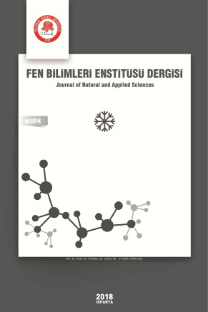Çokgensel Bölgede Keyfi İki Değişkenli Dağılımdan Düzgün Olmayan Rastgele Sayı Üretimi
Non-Uniform Random Number Generation from Arbitrary Bivariate Distribution in Polygonal Area
___
- Tausworthe, R. 1965. Random numbers generated by linear recurrence modulo two. Mathematics of Computation, 19(90), 201-209.
- Hayashi, S., Tanaka, Y., Kodama, E. 2001. A new manufacturing control system using Mahalanobis distance for maximising productivity. Semiconductor Manufacturing Symposium, 2001 IEEE International, 59-62.
- Dougherty, E. 1999. Random processes for image and signal processing. SPIE Optical Engineering Press, 592s.
- Breiman, L. 2001. Random forests. Machine learning, 45(1), 5-32.
- Gottselig, J., Adam, M., Retey, J., Khatami, R., Achermann, P., Landolt, H. 2006. Random number generation during sleep deprivation: effects of caffeine on response maintenance and stereotypy. Journal of sleep research, 15(1), 31- 40.
- Gonzalo, J. 1994. Five alternative methods of estimating long-run equilibrium relationships. Journal of econometrics, 60(1), 203-233.
- Kobayashi, H., Mark, B., Turin, W. 2011. Probability, Random Processes, and Statistical Analysis. Cambridge University Press Textbooks, New York, 812s.
- Berg, H. 1993. Random walks in biology. Princeton University Press, 152s.
- Beard, R. 2013. Risk theory: the stochastic basis of insurance. Springer Science & Business Media, 195s.
- Rukhin, A., Soto, J., Nechvatal, J., Smid, M., Barker, E. 2001. A statistical test suite for random and pseudorandom number generators for cryptographic applications. Booz-Allen and Hamilton Inc McLean Va.
- Ross, S. 2006. Simulation. Elsevier, 285s.
- Yannakakis, G., Togelius, J. 2011. Experiencedriven procedural content generation. Affective Computing, IEEE Transactions on, 2(3), 147-161.
- Fuller, W. 2011. Sampling statistics (Vol. 560). John Wiley & Sons, 472s.
- Devroye, L. 1986. Non-uniform Random Variate Generation. Springer, New York, 843s.
- Rubinstein, R., Kroese, D. P. 2008. Simulation and the Monte Carlo method. John Wiley & Sons, 304s.
- Walck, C. 2007. Handbook on statistical distributions for experimentalists, 190s.
- Boes, D., Graybill, F., Mood, A. 1974. Introduction to the Theory of Statistics. McGraw-Hill, 564s.
- Chu, D., Fotouhi, A. 2009. Distance between bivariate beta random points in two rectangular cities. Communications in Statistics—Simulation and Computation, 38(2), 257-268.
- Haight, F. 1964. Some probability distributions associated with commuter travel in a homogeneous circular city. Operations Research, 12(6), 964-975.
- Wang, M., Kennedy, W. 1990. Comparison of algorithms for bivariate normal probability over a rectangle based on self-validated results from interval analysis. Journal of Statistical Computation and Simulation, 37(1-2), 13-25.
- Robert, C., Casella, G. 2013. Monte Carlo Statistical Methods. Springer Science & Business Media, New York, 649s.
- Gentle, J. E. 2006. Random number generation and Monte Carlo methods. Springer Science & Business Media, New York, 247s.
- Johnson, M. E. 2013. Multivariate statistical simulation: A guide to selecting and generating continuous multivariate distributions. John Wiley & Sons, Canada, 240s.
- Kesemen, O., Doğru, F. 2011. Cumulative Distribution Functions of Two Variable in Polygonal Areas. 7. International Statistics Congress, 28 April – 1 May, Antalya, 150-151.
- Kesemen, O., Uluyurt, T. 2013. Bivariate Chi- Square Goodness of Fit Test in Polygonal Areas. 8. International Statistics Congress, 28-30 October, Antalya, 280-281.
- [26] L'Ecuyer, P. 2012. Random Number Generation. ss 35-71. Genttle J.E., Härdle W. K., Mori Y., ed. 2012. Handbooks of Computational Statistics Springer Berlin Heidelberg, 1192s.
- Burden, R., Faires, J. 2011. Numerical Analysis. Brooks/Cole 7, 912s.
- Thomas, D., Luk, W. 2007. Non-uniform random number generation through piecewise linear approximations. IET Computers A Digital Techniques, 1(4), 312-321.
- Douglas, D., Peucker, T. 1973. Algorithms for the reduction of the number of points required to represent a digitized line or its caricature. Cartographica: The International Journal for Geographic Information and Geovisualization, 10(2), 112-122.
- Haines, E. 1994. Point in polygon strategies. pp 24-26. Heckbert P. S., ed. 1994. Graphics gems IV, Academic Press Professional, Cambridge, 575s.
- Hormann, K., Agathos, A. 2001. The point in polygon problem for arbitrary polygons. Computational Geometry, 20(3), 131-144.
- Gudmundsson, J., Haverkort, H., Van Kreveld, M. 2005. Constrained higher order Delaunay triangulations. Computational Geometry, 30(3), 271-277.
- Shewchuk, J. 1996. Triangle: Engineering a 2D quality mesh generator and Delaunay triangulator. ss 203-222. Lin M.C., Manocha D., eds. 1996. Applied Computational Geometry Towards Geometric Engineering. Lecture Notes in Computer Science, Springer Berlin Heidelberg, 222s.
- Forbes, C., Evans, M., Hastings, N., Peacock, B. 2011. Statistical distributions. New Jersey: John Wiley & Sons, 212s.
- Earth Observation Group (EOG). https://www.ngdc.noaa.gov/eog/. (Date of Access: 27.02.2018).
- Climate Change in Australia. Retrieved from CSIRO and Bureau of Meteorology. http://www.climatechangeinaustralia.gov.au/ (Date of Access: 12.06.2016).
- ISSN: 1300-7688
- Yayın Aralığı: 3
- Başlangıç: 1995
- Yayıncı: Süleyman Demirel Üniversitesi
Buğrahan EMSEN, Ali Aslan DEMİR, Saban Abdullah KAYA
Ufuk KIRBAŞ, Mustafa KARAŞAHİN, Birol DEMİR, Muhammet KOMUT, Emine Nazan ÜNAL
Nursel KOYUNCU, Muhammad HANIF, Shabnam SHAHZADİ, Usman SHAHZAD
Zeynep TUNALI, H. Tuğba DOĞMUŞ-LEHTİJÄRVİ, Funda OSKAY
Buğrahan EMSEN, Ali ASLAN, Abdullah KAYA
A Quantum Space and Some Associated Quantum Groups
Deprem Etkisindeki TSD Yapılarda Histeretik Enerji Talebi: Analitik ve Ampirik Sonuçlar
ε-duyarsız Kuadratik Kayıp Fonksiyonu ile EKG Verilerinin Sıkıştırılması
